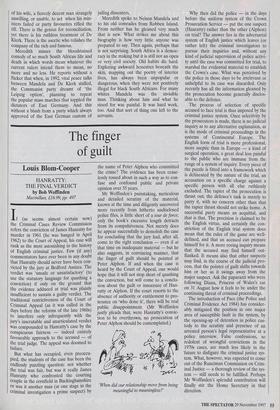The finger of guilt
Louis Blom-Cooper
HANRATTY: THE FINAL VERDICT by Bob Woffinden Macmillan, £16.99, pp. 497 If (as seems almost certain now) the Criminal Cases Review Commission refers the conviction of James Hanratty for murder in 1961 (he was hanged in April 1962) to the Court of Appeal, his case will rank as the most astonishing in the history of English criminal justice. Few (if any) commentators have ever been in any doubt that Hanratty should never have been con- victed by the jury at Bedford Assizes. The verdict was 'unsafe or unsatisfactory' (to use the statutory language for quashing a conviction) if only on the ground that the evidence adduced at trial was plainly Insufficient to sustain a guilty verdict. The traditional restrictiveness of the Court of Criminal Appeal (as it was called in the days before the reforms of the late 1960s) to interfere only infrequently with the Jury's inscrutable and unarticulated verdict was compounded in Hanratty's case by the conspicuous fairness — indeed entirely favourable approach to the accused — of the trial judge. The appeal was doomed to failure.
But what has occupied, even preoccu- pied, the students of the case has been the endlessly puzzling question: not whether the trial was fair, but was it really James Hanratty who confronted the courting couple in the cornfield in Buckinghamshire or was it another man (at one stage in the criminal investigation a prime suspect) by the name of Peter Alphon who committed the crime? The evidence has been cease- lessly tossed about in such a way as to con- fuse and confound public and private opinion over 35 years.
Mr Woffinden's painstaking, meticulous and detailed scrutiny of the material, known at the time and diligently uncovered more recently from hitherto undisclosed police files, is little short of a tour de force; only the book's excessive length detracts from its compulsiveness. Not merely does he appear successfully to demolish the case for concluding that the jury had, after all, come to the right conclusion — even if at that time on inadequate material — but he also suggests, in convincing manner, that the finger of guilt should be pointed at Peter Alphon. If and when the case is heard by the Court of Appeal, one would hope that it will not stop short of quashing the conviction, but will come to a conclu- sion about the guilt or innocence of Han- ratty or Alphon. If the court resorts to the absence of authority or entitlement to pro- nounce on 'who done it', there will be real public disappointment. (Mr Woffinden justly pleads that, were Hanratty's convic- tion to be overthrown, no prosecution of Peter Alphon should be contemplated.) `When did our relationship move from being meaningful to meaningless?' Why then did the police — in the days before the uniform system of the Crown Prosecution Service — put the one suspect (Hanratty) rather than the other (Alphon) on trial? The answer lies in the adversarial system of English justice which leaves (or rather left) the criminal investigators to pursue their inquiries and, without any kind of judicial supervision of police activi- ty until the case was committed for trial, to marshal the evidential material to establish the Crown's case. What was perceived by the police in those days to be irrelevant or unhelpful to its case was discarded. Only recently has all the information gleaned by the prosecution become generally disclos- able to the defence.
The process of selection of specific accused to face trial is thus imposed by the criminal justice system. Once selectivity by the prosecutors is made, there is no judicial inquiry as to any alternative explanation, as is the mode of criminal proceedings in the systems of Continental Europe. The English form of trial is more professional, more aseptic than in Europe — a kind of surgical operation, a great deal less painful to the public who are immune from the range of a system of inquiry. Every piece of the puzzle is fitted into a framework which is delineated by the nature of the trial, an accusation on a specific charge against a specific person with all else ruthlessly excluded. The rapier of the prosecution is thrust out; the defence's task is merely to parry it, with no concern other than that the rapier thrust should not strike home. A successful parry means an acquittal, and that is that. The precision is claimed to be the English virtue, and certainly the con- striction of the English trial system does mean that the rules of the game are well- defined, and that an accused can prepare himself for it. A more roving inquiry means that the accused may find himself out- flanked. It means also that other suspects may find, in the course of the judicial pro- cess, that the pointer of guilt shifts towards him or her as it swings away from the major suspect. Ask the paparazzi who were following Diana, Princess of Wales's car on 31 August how it feels to be under the continuing threat of criminal proceedings.
The introduction of Pace (the Police and Criminal Evidence Act 1984) has consider- ably mitigated the position in one major area of susceptible fault in the system, by the opening-up of detention in police cus- tody to the scrutiny and presence of an arrested person's legal representative at a police interview. False confessions, so redolent of wrongful convictions in the 1970s cases, are much less likely in the future to disfigure the criminal justice sys- tem. What, however, was expected to come out of the Runciman Commission on Crim- inal Justice — a thorough review of the sys- tem — still needs to be fulfilled. Perhaps Mr Woffinden's splendid contribution will finally stir the Home Secretary in that direction.


















































































 Previous page
Previous page